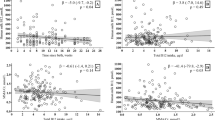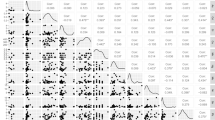Abstract
Availability of rapid, point-of-contact analytical methods would facilitate the use of breast milk vitamin A concentration (BMVA) to assess vitamin A (VA) status. We compared BMVA concentrations measured by high-performance liquid chromatography (HPLC) (the standard technique) with those by iCheck FLUORO, a new portable fluorometer that can rapidly quantify BMVA. Casual breast milk samples (n=154) were collected during a representative survey in Yaoundé and Douala, Cameroon. Milk fat and BMVA concentrations (by iCheck) were measured in fresh milk in the field. After storage at <−20 °C, BMVA concentrations were also measured by HPLC. BMVA values from the two methods were highly correlated (R2=0.72 for BMVA/l; R2=0.62 for BMVA/g fat, both P<0.0001). HPLC values were greater than iCheck values on average, and the difference increased with increasing BMVA. The iCheck FLUORO could be useful for monitoring fortification programs, but before–after surveys to assess change in BMVA concentrations should use one method consistently.
This is a preview of subscription content, access via your institution
Access options
Subscribe to this journal
Receive 12 print issues and online access
$259.00 per year
only $21.58 per issue
Buy this article
- Purchase on Springer Link
- Instant access to full article PDF
Prices may be subject to local taxes which are calculated during checkout

Similar content being viewed by others
References
Stoltzfus RJ, Underwood BA . Breast-milk vitamin A as an indicator of the vitamin A status of women and infants. Bull World Health Organ 1995; 73: 703–711.
Schweigert FJ, Frey SK, Mothes R, Dary O, Juarez P, Lascano V . A new test kit's potential for the rapid analysis of vitamin A in human and cow milk. Sight and Life Magazine 2011; 25: 18–22.
Engle-Stone R, Ndjebayi AO, Nankap M, Brown KH . Consumption of potentially fortifiable foods by women and young children varies by ecological zone and socio-economic status in Cameroon. J Nutr 2012; 142: 555–565.
Lucas A, Gibbs J, Lyster R, Baum J . Creamatocrit: a simple clinical technique for estimating fat concentration and energy value of human milk. Br Med J 1978; 1: 1018–1020.
Lunetta J, Zulim R, Dueker S, Lin Y, Flaig V, Schneider P et al. Method for the simultaneous determination of retinol and beta-carotene concentrations in human tissues and plasma. Anal Biochem 2002; 304: 100–109.
van Kuijk F, Handelman G, Dratz E . Rapid analysis of the major classes of retinoids by step gradient reversed-phase high-performance liquid chromatography using (O-ethyl) oxime derivatives. J Chromatogr 1985; 348: 241–251.
Bland JM, Altman DG . Measuring agreement in method comparison studies. Stat Methods Med Res 1999; 8: 135–160.
Engle-Stone R, Haskell MJ, Ndjebayi AO, Nankap M, Erhardt JG, Gimou M-M et al. Plasma retinol-binding protein predicts plasma retinol concentration in both infected and uninfected Cameroonian women and children. J Nutr 2011; 141: 2233–2241.
Engle-Stone R, Haskell M, Nankap M, Ndjebayi AO, Brown KH . Breast milk retinol and plasma retinol-binding protein concentrations provide similar estimates of vitamin A deficiency prevalence and identify similar risk groups among women in Cameroon but breast milk retinol underestimates the prevalence of deficiency among young children. J Nutr 2014; 144: 209–217.
Acknowledgements
We thank Daniela Hampel (USDA, Davis, CA, USA) for NIST formula verification. This study was supported by Sight and Life (Basel, Switzerland).
Author Contributions
RES is the guarantor of the manuscript and had full access to all the data in the study and takes responsibility for the integrity of the data and the accuracy of the data analysis. RES, MJH, KHB: study concept and design; RES, AON, MN: sample acquisition and field analyses; MRL: laboratory analysis; RES: data analysis and drafting of the manuscript; RES, MJH, MRL, AON, MN, KHB: critical revision of the manuscript for intellectual content.
Author information
Authors and Affiliations
Corresponding author
Ethics declarations
Competing interests
The authors declare no conflict of interest.
Rights and permissions
About this article
Cite this article
Engle-Stone, R., Haskell, M., La Frano, M. et al. Comparison of breast milk vitamin A concentration measured in fresh milk by a rapid field assay (the iCheck FLUORO) with standard measurement of stored milk by HPLC. Eur J Clin Nutr 68, 938–940 (2014). https://doi.org/10.1038/ejcn.2014.63
Received:
Revised:
Accepted:
Published:
Issue Date:
DOI: https://doi.org/10.1038/ejcn.2014.63
This article is cited by
-
Low breastmilk vitamin A concentration is prevalent in rural Ethiopia
European Journal of Clinical Nutrition (2019)
-
Validation of blood vitamin A concentrations in cattle: comparison of a new cow-side test (iCheck™ FLUORO) with high-performance liquid chromatography (HPLC)
BMC Veterinary Research (2017)
-
AURORA: bariatric surgery registration in women of reproductive age - a multicenter prospective cohort study
BMC Pregnancy and Childbirth (2016)



